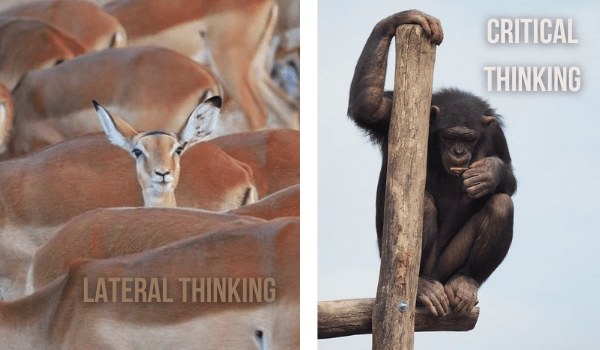The way we need two eyes, two hands, two legs and yes, two brains – left brain and right brain – businesses also need both critical thinkers and lateral thinkers in order to be successful. It’s rather difficult to say who is up on the hierarchy of importance, as it would completely depend on the stage or phase the business is in, or on the nature of the problem or situation.
Companies, of course, wish that they find both lateral thinking and critical thinking capabilities in one person, but that’s like finding a true gem from a pile of stones. These are two completely different approaches to thinking.
Lateral thinkers approach a problem creatively and solve it using unconventional ways or new approaches, and critical thinkers rely on facts and analyses to resolve issues.
So how does one identify a critical thinker or a lateral thinker?
Critical thinkers are always curious, which is why they constantly upgrade their knowledge, and engage in independent self-learning. Besides, they are objective and introspective, and can identify biases, determine relevance and inference and have an analytical bent of mind. In short, they have all the traits required to become a leader, riding on new planes of self-improvement and self-actualisation. Situational interviews are the best way to identify and hire a critical thinker.
“A one-way thought process doesn’t work, especially for the leaders.”
Sunil Kumar, CHRO, PVR
Lateral thinking requires discarding the obvious, leaving behind traditional modes of thought, and erasing preconceptions. Candidates with lateral-thinking skills will come out with multiple perceptions for the same thing. For a simple question such as , ‘what’s a car’, lateral thinkers may answer with ‘an equipment that shortens the distance between two places’. They may be able to equate a square with a circle, by pointing out that when a square rotates at high speed, its centre appears to be a circle. Only people with lateral thinking skills will be able to relate the two shapes in such a manner.
In organisations, owing to their highly heterogeneous nature, different roles and functions require different thought processes for their smooth functioning. A leader has to have critical thinking abilities, but lateral thinking abilities can be found across levels.
Sunil Kumar, CHRO, PVR, says, “For certain routine functions, it is better to have lateral thinkers on board, but for role-specific functions, it is advisable to hire critical thinkers.”
“There are certain leaders – given the fact that they have already been through various positions throughout their career – who are able to kind of switch quickly between lateral thinking and critical thinking, as per needs.”
Nitin Thakur, head of L&D, Jindal Stainless
According to Mahipal Naiyar, CHRO, South Asia, NielsenIQ, critical and specialised thinkers are preferred for tasks, such as business analytics and accounts, because of the very nature of the function. However, when it comes to any activity that involves the challenging of possibilities, a lateral thinker may fit better.”
“When a problem demands a creative solution or an idea that lies beyond the boundaries, only laterally-processed thoughts can come to the rescue,” he adds.
The demand for lateral thinkers and critical thinkers also changes with hierarchy. As individuals move up the hierarchy, they are confronted with different situations that will call upon both types of thought processes.
“A one-way thought process doesn’t work, especially for the leaders,” says Kumar of PVR.
“At the leadership level, one has to look way beyond the certified boundaries and designations, as leaders have to take charge of a group comprising people belonging to different functions. However, at the junior levels, it completely depends on what role one is playing. But, it will undoubtedly be a gift for companies to have a mix of lateral-thinking and critical-thinking talents,” concurs Nitin Thakur, head of L&D, Jindal Stainless.
“When a problem demands a creative solution or an idea that lies beyond the boundaries, only laterally-processed thoughts can come to the rescue.”
Mahipal Naiyar, CHRO, South Asia, NielsenIQ
Though at the junior levels, what to implement depends on the role and the assigned job function alone, switching from one kind of thought process to the other can be a miraculous feat, which may be mastered by geniuses over time, with experience. Thakur reminds that there are certain leaders – given the fact that they have already been through various positions throughout their career – who are able to kind of switch quickly between lateral thinking and critical thinking, as per needs.”
“The skill to think critically helps when it comes to streamlining the ideas. At times, situations also emerge that demand 360-degree thinking,” opines Kumar of PVR.
(With inputs from Sudeshna Mitra)



